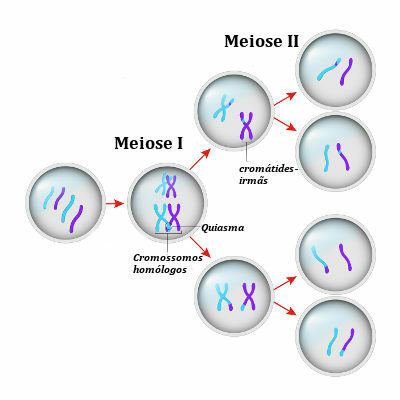Cell division is a process in which one cell, called a mother cell, divides and gives rise to another, called a daughter cell. At mitosis, a cell divides into two diploid daughter cells, and in the meiosis, the end of the process generates four haploid cells. Meiosis is, therefore, a process of reductive division.
→ Meiosis phases
Meiosis starts after the doubling of chromosomes, which occurs at the so-called interphase. After this duplication, the first of the two divisions that will take place in this process of cell division begins.
First Meiotic Division
Prophase I: At this stage, initially, the pairing of homologous chromosomes is observed. This pairing is called synapse, and the homologous chromosomes are here called bivalent. At this point, the call c may occur.Rossing-over, that happens when portions of the chromatids are broken up and joined to corresponding segments in their counterparts. The points at which the crossing over have the X-shaped conformation and are called chiasmas.
At the end of prophase 1, the envelope of the nucleus fragments and the homologous pairs move towards the metaphase plate. As it is a very long phase, it is usually divided into five subphases: leptothene, zygotenum, pachytene, diplotene and diakinesis.Metaphase I: The homologous chromosome pairs are arranged on the metaphase board, in the middle region of the cell. The chromatids of one homologue are attached to the microtubule of the kinetochore at one pole, and the other chromatids are attached to the microtubule of the opposite pole.
Anaphase I: The homologous chromosomes separate and move towards the poles opposites guided by the spindle fibers. Note that at this point the centromeres do not separate and the chromatids remain together. The separation takes place only between the counterparts.
Telophase I: Each half of the cell forms a complete haploid set of duplicated chromosomes, made up of two sister chromatids. Simultaneously with this phase, the cytokinesis, which separates the cell into two daughter cells.

Note a representation of the meiosis process
Second Meiotic Division
Prophase II: Spindle fibers form, and the chromosomes (with their two chromatids) are moved toward the metaphase plate.
Metaphase II: Chromosomes are positioned in the middle region of the cell. The sister chromatid kinetochores are attached to the microtubule at each pole.
Anaphase II: occurs to separation of sister chromatids, and each of them goes to an opposite pole.
Telophase II: The nucleus is formed, the chromosome decondenses and a new cytokinesis takes place. At this point, four daughter cells are formed, with half the number of chromosomes of the cell that originated them.
→ Meiosis function for animals and plants
This cell division process is very important for animals and plants because, in these groups, it is related to gamete production or from spores (in plants). By reducing the number of chromosomes by half, this process guarantees, after fertilization, the reestablishment of the number of chromosomes in a species. In addition, meiosis makes genetic variability possible.
By Ma. Vanessa dos Santos
Source: Brazil School - https://brasilescola.uol.com.br/o-que-e/biologia/o-que-e-meiose.htm
